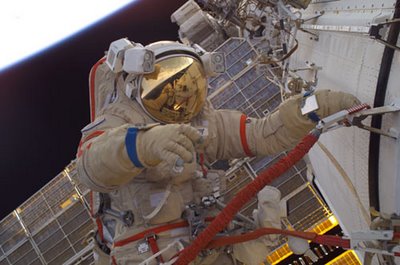
[Image: NASA].
Qibla is the direction that a Muslim must face when praying – specifically, toward the Kaaba, in Mecca. In order to align oneself properly with that religious axis mundi, all kinds of complicated mathematical techniques had to be used or developed. From compasses to azimuths – to spherical trigonometry – determining what angle to take in relation to the horizon became as much a mathematical, or geographic, pursuit as it was religious.
So now, as Malaysia prepares to send three Muslim astronauts into space, the question of qibla has once again been revived: in what direction should an astronaut pray in order to face Mecca? As that last link reminds us, these astronauts "will also visit the International Space Station, which circles the earth 16 times in 24 hours, so another thorny question is how to pray five times a day as required by Islam."
I'm imagining a bewildering series of gyroscopes, mirrors, magnets and platforms – called the Prayer Chair – with arms covered in quantum clocks, ticking off "days" where there are none, keeping time in space devoid of terrestrial references. Motors will click and whir, aligning the chair constantly, and whole new branches of robotics – RoboQibla™ – gyroPrayer® – will take off. Science academies throughout the Muslim world will start producing new and strange direction sensors, devices of alignment that'd make John Dee proud and Athanasius Kircher whistle. New space stations designed by architecture students in Dubai will show us the future of intercelestial travel: self-unfolding, solar-powered spaceships, ceaselessly rotating in space – whilst maintaining perfect ship-to-Mecca alignment.
The Jesuits respond with floating cathedrals... flying buttresses in space.
(Original article spotted at Off Center).
No comments:
Post a Comment